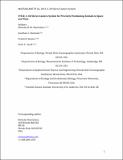Files in this item
A 3D stereo camera system for precisely positioning animals in space and time
Item metadata
| dc.contributor.author | Macfarlane, Nicholas | |
| dc.contributor.author | Howland, Jonathan | |
| dc.contributor.author | Jensen, Frants | |
| dc.contributor.author | Tyack, Peter Lloyd | |
| dc.date.accessioned | 2016-02-28T00:11:58Z | |
| dc.date.available | 2016-02-28T00:11:58Z | |
| dc.date.issued | 2015-04 | |
| dc.identifier | 172090190 | |
| dc.identifier | 3448963a-a371-4d19-b5cf-25c79b2fe62d | |
| dc.identifier | 000351235100018 | |
| dc.identifier | 84925485671 | |
| dc.identifier.citation | Macfarlane , N , Howland , J , Jensen , F & Tyack , P L 2015 , ' A 3D stereo camera system for precisely positioning animals in space and time ' , Behavioral Ecology and Sociobiology , vol. 69 , no. 4 , pp. 685-693 . https://doi.org/10.1007/s00265-015-1890-4 | en |
| dc.identifier.issn | 0340-5443 | |
| dc.identifier.other | ORCID: /0000-0002-8409-4790/work/60887865 | |
| dc.identifier.uri | https://hdl.handle.net/10023/8330 | |
| dc.description | PLT was supported by the Scottish Funding Council (grant HR09011) through the Marine Alliance for Science and Technology for Scotland. | en |
| dc.description.abstract | Here, we describe a portable stereo camera system that integrates a GPS receiver, an attitude sensor and 3D stereo photogrammetry to rapidly estimate the position of multiple animals in space and time. We demonstrate the performance of the system during a field test by simultaneously tracking the individual positions of six long-finned pilot whales, Globicephala melas. In shore-based accuracy trials, a system with a 50-cm stereo baseline had an average range estimation error of 0.09 m at a 5-m distance increasing up to 3.2 at 50 m. The system is especially useful in field situations where it is necessary to follow groups of animals travelling over relatively long distances and time periods whilst obtaining individual positions with high spatial and temporal resolution (up to 8 Hz). These positions provide quantitative estimates of a variety of key parameters and indicators for behavioural studies such as inter-animal distances, group dispersion, speed and heading. This system can additionally be integrated with other techniques such as archival tags, photo-identification methods or acoustic playback experiments to facilitate fieldwork investigating topics ranging from natural social behaviour to how animals respond to anthropogenic disturbance. By grounding observations in quantitative metrics, the system can characterize fine-scale behaviour or detect changes as a result of disturbance that might otherwise be difficult to observe. | |
| dc.format.extent | 9 | |
| dc.format.extent | 5749790 | |
| dc.language.iso | eng | |
| dc.relation.ispartof | Behavioral Ecology and Sociobiology | en |
| dc.subject | Photogrammetry | en |
| dc.subject | Group cohesion | en |
| dc.subject | Collective behaviour | en |
| dc.subject | Geo-location | en |
| dc.subject | Range-finding | en |
| dc.subject | QH301 Biology | en |
| dc.subject | GC Oceanography | en |
| dc.subject | NDAS | en |
| dc.subject.lcc | QH301 | en |
| dc.subject.lcc | GC | en |
| dc.title | A 3D stereo camera system for precisely positioning animals in space and time | en |
| dc.type | Journal article | en |
| dc.contributor.sponsor | Naval Facilities Engineeering | en |
| dc.contributor.institution | University of St Andrews. School of Biology | en |
| dc.contributor.institution | University of St Andrews. Marine Alliance for Science & Technology Scotland | en |
| dc.contributor.institution | University of St Andrews. Sea Mammal Research Unit | en |
| dc.contributor.institution | University of St Andrews. Sound Tags Group | en |
| dc.contributor.institution | University of St Andrews. Bioacoustics group | en |
| dc.contributor.institution | University of St Andrews. Scottish Oceans Institute | en |
| dc.identifier.doi | 10.1007/s00265-015-1890-4 | |
| dc.description.status | Peer reviewed | en |
| dc.date.embargoedUntil | 2016-04-01 | |
| dc.identifier.grantnumber | en |
This item appears in the following Collection(s)
Items in the St Andrews Research Repository are protected by copyright, with all rights reserved, unless otherwise indicated.

